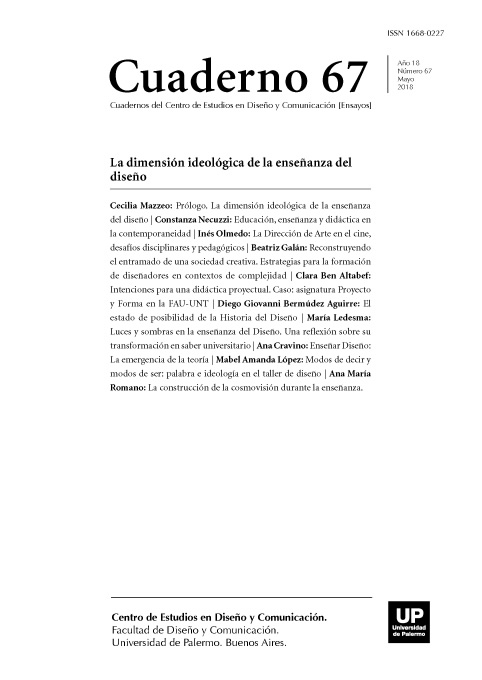Modos de decir y modos de ser: palabra e ideología en el taller de diseño
Abstract
What is the contribution of the word to design teaching? Verbal mediation is fundamental for the development of didactic instances: exposition, work instructions, colloquiums, project criticism. The imposition of one language on another is not insignificant; the word never exhausts the latent meanings of graphic language.
Specifically in individual reviews, teacher and student interact through the word; they also speak with their gestures, laughter and silence. As a result of the analysis, a triadic model emerges to characterize the functions of the teacher’s word (verbal, gestural, graphic). The teacher is involved in the student’s project 1) asking, 2) theoretically reformulating and 3) proposing resolutions. These strategies mark the scene, depending on the position adopted. The dialogical skills of the teachers facilitate or obturate the communication. In turn, the implicit contract that will guide the dialogue, as an intersubjective praxis, has a direct implication in the performance of both parties involved.
References
Balacheff, N. (1988). “Le contrat et la coutume, deux registres des interactions didactiques” en Actes du premier colloque franco-allemand de didactiques des mathématiques et de l’informatique. Lumigny (Grenoble: La Pensée sauvage).
Becher, T. (2001). “Las disciplinas académicas” en Tribus y Territorios académicos: La indagación intelectual y las culturas de las disciplinas. Barcelona: Gedisa.
Benveniste, E. (1966). Problèmes de linguistique générale. París: Gallimard. Edición en espa- ñol: Problemas de Lingüística General. Tomo 1 (1971). México: Siglo veintiuno editores.
__________. (1970). “El aparato formal de la enunciación”. En Problemas de lingüística general II (1978). México: Siglo xxi. Bourdieu, P. (1989). “El mercado lingüístico”. En Sociología y cultura. México: Grijalbo.
Brousseau, G. (1984). “Le rôle central du contrat didactique dans l’analyse et la construction des situations d’enseignement et d’apprentissage des mathématiques”. En Actes de la 3 École d’été de didactique des mathématiques. Grenoble: Université, IMAG.
__________. (1986). “Fondements et méthodes de la didactique des mathématiques”. En Recherches en didactique des mathématiques, 7.2. Grenoble: La Pensée sauvage.
Chevallard, Y. (1983). Remarques sur la notion de contrat didactique, Intervención ante el grupo Inter-IREM. Aviñón, multicopiada.
Cole, M. y Engeström. Y. “Enfoque histórico-cultural de la cognición distribuida”. En Distributed Cognitions. Psichological and educational considerations, Gavriel Salomon (ed.) (1993). Cambridge, Cambridge University Press. Traducción al español de Eduardo Sinnott, Cogniciones distribuidas. Consideraciones psicológicas y educativas. Buenos Aires: Amorrortu.
Doberti, R. (1992). Lineamientos para una teoría del habitar. Buenos Aires: Colegio de Arquitectura de la Provincia de Buenos Aires.
Fairclough, D. (1992). Discourse and Social Change. Cambridge: Cambridge University Press.
Filloux, J. (1974). Du contrat pédagogique, le discours inconscient de l’école. Paris: Dunod.
Foucault, M. (1969). L’archéologie du savoir.París: Gallimard. Trad. española Garzón del Camino, A. (1970). La arqueología del saber. México: Siglo XXI.
Kerbrat-Orecchioni, C. (1979). L’ Énonciation. De la subjetivité dans le langage. París: Armand Colin. Traducción española por Gladis Anfora y Emma Gregores (1997). La enunciación. De la subjetividad en el lenguaje. Buenos Aires: Edicial. __________. (1986). “Nouvelle Communication et Analyse conversationnelle” en Langue Françoise 70.
López, M. (2007). “El diálogo en la enseñanza del proyecto gráfico: simetría y complementariedad”. En Symmetry: Art and Science, (Journal of the international Society for the Interdisciplinary Study of Simmetry), ISSN 0865-4824, año 2007, 2-4, págs. 322-325.
Maillo Puente, L. (2015). “Desarrollo de competencias del docente del taller de diseño gráfico mediante la reflexión y acción”. En SI+TER, Investigaciones territoriales: experiencias y miradas. Buenos Aires: Publicaciones digitales SIFADU / Guillermo Rodríguez y Gabriela Sorda Editores, págs. 175-186, ISBN 978-950-29-1577-7. Disponible en http://www.fadu.uba.ar/post/821-220-actas-de-jornadas-anuales-ao-2015-si-ter
Perrenoud, P. (1994). Métier d’ élvève et sens du travail scolare. Paris: ESF.
St Claire y Gilles, H. (1980). “The functions of no verbal signs in conversation”. En The social and psychological contexts of language. Hillsdale, Nueva York: Eribaum.
Verón, E. (1985). “El análisis del ‘Contrato de Lectura’, un nuevo método para los estudios del posicionamiento de los soportes de los media”. En Les Medias: Experiences, recherches actuelles, aplications. Paris: IREP.
__________. (1993). “El tercer término”. En La semiosis social.Barcelona: Gedisa.
Vygotsky, L. S. (1934). Thinking and speech. Nueva York: Plenum, 1987.
__________. (1934). Thougth and Language. Cambridge, Mass: M.I.T. Press, 1962.
Watzlawick, P.; Bavelas Beavin, J. y Jackson, Don D. (1967). Pragmatics of human communication. Nueva York: W. W. Norton & Company. Traducción al español: Teoría de la comunicación humana. Interacciones, patologías y paradojas (1987). Barcelona: Herder.
Los autores/as que publiquen en esta revista ceden los derechos de autor y de publicación a "Cuadernos del Centro de Estudios de Diseño y Comunicación", Aceptando el registro de su trabajo bajo una licencia de atribución de Creative Commons, que permite a terceros utilizar lo publicado siempre que de el crédito pertinente a los autores y a esta revista.


